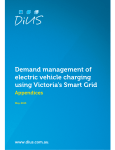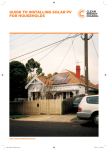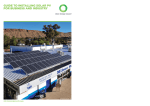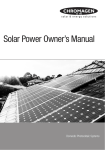Download Indigo Shire Guide - A4.pub
Transcript
1 Table of Contents Introduction……………………………………………………………. 3 Glossary……………………………………….……...………… 4 Section 1: Solar Technology & Energy Generation……………. 5 Section 2: Understanding Your Electricity Consumption….… 12 Section 3: Solar PV Installation & Grid Connection…………… 17 Solar North East Project Summary……………………………….. 28 Case Study - Public Hall Wahgunyah School of Arts…………. 29 Helpful Resources…………………………………………………… 30 2 Introduction Welcome to the Solar Panel Installation Guide This guide is designed to provide Indigo Shire residents with an understanding of the process of installing solar to generate electricity. The first section provides information about solar technology and energy generation. This is followed by a section aimed to improve understanding of energy consumption and electricity account data. Section three summarises the installation and grid connection process, outlining what is required at each step along the way, and provides some helpful tips to minimise obstacles. The benefits of going solar Producing your own renewable energy by installing solar photovoltaic (PV) panels is a great way to reduce your electricity bills and carbon footprint. Making an investment in solar may secure your future energy needs and protect your property from the uncertainty of rising electricity costs over the long term. Electricity prices, usage and greenhouse gas emissions Electricity prices in the North East Victoria SP-AusNet distribution area increased 40% from 2006 to 2012 according to the Victorian Essential Services Commission*. Such price rises have placed a strain on budgets and encouraged people to rethink the way they use and generate electricity. There are a number of reasons why we are paying more for grid supplied electricity. 1. Network costs. Upgrades to the ageing network that delivers electricity to your property - infrastructure such as substations, poles, wires. 2. Increase in the wholesale cost of electricity. 3. Electricity retail profits and cost increases. *Essential Services Commission, May 2013, http://www.esc.vic.gov.au/getattachment/18cdbfc 4-107b497a-ab59-6cce797957c7/Electricity-Retail-Margins-Discussion-Paper.pdf 3 Installing solar electricity can greatly reduce the demand for grid electricity and your properties carbon emissions. Glossary W A watt measures the rate of energy conversion or transfer. 1 watt = 1 joule per second. kW 1 kilowatt = 1,000 watts. For example, a 3 kilowatt size solar system = 3,000 watt system. kWh Kilowatt hours is a measure of energy usage over time. 1 kilowatt hour = 1 kilowatt used for an hour. It is commonly used as a billing unit for energy delivered to consumers by electricity retailers. Distributor The business that owns the power infrastructure (poles, wires and substations) which delivers electricity from a generator to a consumer. Distributors fix faults such as black outs and damaged electricity lines. SP-AusNet is the distributor across Indigo Shire. Generator Generators produce electricity from coal or gas and renewable sources such as solar, hydro, and wind. Retailer A retailer buys electricity from a generator and sells it to a consumer. Retailers set their own prices for consumers. Changing retailer will not change your distributor or affect the reliability or quality of your supply. 4 Section 1: Solar Technology & Energy Generation How does a typical grid connected solar PV system work? Sunlight creates a flow of electrons through the solar cells of a photovoltaic panel. This direct current (DC) travels to the inverter where it is changed to an alternating current (AC). Alternating current is what is used in your home and in the electricity grid. In general, solar electricity will be set up to supply your property’s needs first. Any surplus power, not used at the time of generation, will flow into the electricity grid where you may receive a “feed-in” tariff. When your electricity requirements are greater than the PV output, for instance overnight when the cells are not active, electricity can be purchased directly from the grid. Once a solar PV array is fully installed, they require little maintenance and can be expected to last 20 years or more. Inverters have a shorter life expectancy of between 10 and 15 years. 5 Panel technology Not all solar PV panels are the same. A wide range of products are available and it is extremely important to scrutinise the quality, performance and durability of various technology and brands. There are three main types of panels. 1. Monocrystalline 2. Polycrystalline 3. Amorphous silicon panels or “thin film” Monocrystalline and polycrystalline panels sandwich silicon crystals between a top layer of tempered glass, and a tough ethylene vinyl acetate material underneath. Each cell of a monocrystalline panel is made from a thin slice of a large single silicon crystal, hence the name ‘mono-crystalline’. Monocrystalline Panel Polycrystalline panels have a speckled appearance as a result of the multiple small crystals that make up each cell on the panel. Amorphous silicon panels also known as “thin film” technology, may be less efficient, but do have some advantages. They can be applied as a film to low cost glass or plastic in a variety of sizes. Some types are less susceptible to hail Polycrystalline Panel damage than glass covered panels due to a more flexible upper coating. Also photovoltaic glass, which is a thin film sandwiched between glass, is available for direct incorporation into buildings. Thin Film Technology 6 Solar panel angle and orientation Solar PV panels have the capacity to generate the greatest power when they are pointed directly at the sun. Peak sun hours vary throughout the year and from region to region. As a result, it is important to individually consider each unique location and install panels so they receive maximum direct sunlight. To optimise yield in Australia: • A northern orientation is preferred for fixed PV systems. • A minimum angle of panel tilt of 10° is recommended to maximise self cleaning by rainfall. • In Indigo Shire a 20° - 30° angle of tilt is recommended to maximise annual power production. • When roof pitch is not ideal installers can provide mounting frames, usually at an additional cost, to improve positioning. (Ask your installer to advise of possible differences in output efficiency for different angles and orientations.) Sun tracking systems are also available. Panels are mounted on a motorised stand-alone frame which follows the suns path across the sky. Frames used on a flat roof to correct tilt and orientation. Sun tracking 4.3kW system installed at Wangaratta’s Eco Living Centre. 7 Panel performance tolerance Solar PV panels are rated at a specific output range, for example 200W, with a +/- output tolerance. This means that in the case of a 200W panel with an output tolerance of +/-3%, it is possible that the true panel output could be 194W to 206W, with an average of 200W. Unfortunately, the average output is not what counts when the panels are connected or wired in series within an array. Panels with a greater output do not compensate for those with lower output. Instead the current from the worst (lowest specific output) panel dictates the overall current in the array, and hence the output of all panels. This could mean that a 2.00kW system may in fact only be 1.94kW due to this effect. For this reason panels with a zero negative (or positive only) output tolerance, for example -0% +3%, may be more desirable. With a zero negative output tolerance panel, you can be sure that the watts per panel output rating is the minimum, and that the full rated output of an array is likely to be more accurate. Shading on panels Solar panels should be located where they will be in full sun for the greatest proportion of the day. Shading changes the flow of electricity through the panel. Even a small amount of shade, from objects such as trees, roof ventilators or antennas, can significantly affect panel output. This may impact the entire array and not just the shaded cells. Shading of panels from the projecting roof line will affect the system’s generation capacity. 8 Cleaning your panels Over time, accumulation of dust and dirt may shade the panels and affect their output efficiency. Rain will lightly wash the panels but you may wish to clean your panels occasionally to maintain efficiency, particularly during dry dusty periods of low rainfall. How does temperature affect solar panel output? Solar panels operate best during clear conditions and at ambient temperatures up to 25°C. As the ambient temperature increases above this level, panels can experience varying levels of reduced efficiency. Ensure you receive a panel technical specification sheet when you are provided with a quote. Specifications will provide a temperature co-efficient that will help you determine the percentage of reduced efficiency per degree rise in temperature. This will enable you to obtain a clearer picture of the variation in generating capacity for different types and models of panels. The lower the number for the temperature coefficient, the better the panel will work in higher temperatures. In addition, install panels so they are slightly elevated from the roof surface. This will allow for air to circulate underneath and keep the panels cooler. 9 Selecting an inverter The inverter is an expensive component of your solar PV energy system. Just like solar panels, not all inverters are the same and replacement of a failed inverter can be a considerable cost. It is extremely important to consider the quality, performance and longevity of the inverter. Research brands and manufacturers to source inverter equipment with a strong reputation and low failure rates. Micro inverters are also available. They are fitted at numerous locations across the solar array rather than having one central inverter. The key benefit of this type of inverter arrangement is that failure or reduced performance of one panel will not affect the energy production across the entire system. Ideally inverters should be installed in a shaded position with good air flow. A home monitor or web based program can obtain power generation and usage data registered by your inverter. This allows you to easily track the solar system’s electricity production and the property's consumption pattern. Such information can highlight opportunities to reduce electricity demand and promptly respond to any irregularities with the system. This German made SMA SunnyBoy inverter (left) includes a Sunny Beam monitor (above). 10 Battery supported grid connect systems Grid connected battery storage systems are also available. They allow the storage and use of surplus energy generated by domestic renewable energy systems. Batteries can also be charged from the grid during off–peak times for use during peak tariff periods. These storage systems have the potential to secure continual supply by providing energy to your home during a grid power outage. The cost of battery connect systems are becoming more affordable as technology improves. Off-grid stand alone systems For properties that are not connected to the electricity grid network, battery storage systems are available. Such systems offer significant advantages for users independent of the electricity grid, however they do require careful battery management. Ask installers for options suitable to your scenario. Net Metering ‘Net metering’ applies to grid connected energy systems that feed excess power back into the grid. This means that energy generated by your solar installation will be consumed first at the property. Any surplus energy generated will flow back through your meter where it will be measured as it is exported to the grid and may be eligible to receive a “feed-in” tariff. The meter will only record exported kilowatt hours (kWh) if the electricity generation exceeds your consumption during a particular time interval. Export is calculated every half hour. For example: your home consumes 10 kilowatt hours during a time interval and your solar installation generates 2 kilowatt hours during that same period. The meter will advance 8 kilowatt hours on the total usage register, the difference between import and home generation. 11 Section 2: Understanding your Electricity Consumption An important first step before you install solar electricity is understanding what information is provided on your electricity account and where power is used in your home. With this material you can: 1. Recognise consumption patterns; and 2. Explore options to reduce demand - using both technology and modified behaviour. By improving energy efficiency and using less power you can consider a smaller sized solar system to meet your needs. This will lower your capital outlay. Top tips to reduce your electricity demand ! Where possible look for non–electrical means of heating water and living areas. If you are using mechanical heating and cooling reduce the area being targeted and dress appropriately. Set thermostats between 18-20°C in winter and 25°C or above in summer. Every degree warmer or cooler can increase energy use by up to 10%. Increase the insulation in your home and reduce draughts. Reduce “standby loads” and switch off lights and appliances that are not in use. When replacing appliances look at star rating and purchase efficient models. Replace light fittings with LED or compact fluorescent equivalents. 12 Monitor your usage There are a number of ways to examine your electricity use at home. You can analyse information provided on your energy bills, regularly read and record you electricity meter, and if you have a smart meter you may be able to access web portals that provide real-time data on your property’s consumption. Calculating your average daily power usage from your energy bills The average daily domestic electricity consumption, measured in kilowatt hours per day (kWh/day), varies widely from household to household. Electricity use will normally vary between summer and winter depending on heating and cooling requirements. How do I determine my average daily usage in kilowatt hours (kWh)? Look at your most recent electricity bills, ideally electricity bills that cover a 12 month period - bills are generally issued monthly or quarterly. 1. Note your average daily use in kWh for each bill. (Each bar for the last 12 months on the bar chart of your most recent bill, OR the average daily use listed on each bill over a 12 month period - see page 14). 2. Calculate your average annual daily use in kWh by adding together the monthly or quarterly figures, then dividing by 12 (monthly) or 4 (quarterly) depending on billing cycle. In the example shown on page 14, starting from Dec ‘10, the annual daily average is calculated as: 9.9 + 8.0 + 13.4 + 16.2 = 11.9 kWh 4 This is the amount of electricity used on site each day, averaged across a whole year. You will then be able to gauge the likely impacts of any proposed solar system on your daily consumption. 13 *Electricity bills vary between electricity retailers - some bill quarterly, others monthly. 14 Sizing your solar power system Once you know how much electricity your property uses, and you have addressed any opportunities to reduce your power use, you should think about what you want to achieve from your solar PV system. A number of factors will affect the impact a solar PV system has on your electricity account. These include: ♦ Roof design and aspect ♦ Budget ♦ Energy consumption ♦ System size ♦ Time of use ♦ Feed-in tariffs These elements will influence whether you will be able to offset some, or all of your electricity needs, and whether exporting excess electricity to the grid is a viable option. Installers should indicate the average daily amount of electricity in kilowatt hours per day (kWh/day) that systems will generate. If they do not offer this information, ask them to provide it. You can use these daily output figures to compare against your electricity consumption which will help you choose a system that best meets your needs. To assess options, arrange for a number of solar installers to conduct a site inspection and provide a quote for your project. The representative should inspect your meter box, roof area, pitch, orientation, and determine any shading limitations. They should also undertake a billing analysis to determine your usage and discuss sizing solutions. When this information has been collected and assessed a quote can be issued for your consideration. 15 IMPORTANT: your electricity bill has a “fixed” component, sometimes listed as a “Supply Charge”, which you will be charged even if your solar system offsets all of your electricity use. If you want to obtain a $0 bill or a credit, you will need to install a system that produces more electricity than your electricity consumption to cover this supply charge. Depending on the available feed-in tariff this option may or may not be attractive and can significantly impact payback periods for your PV investment. What else can I do? To obtain further information on simple ways to improve energy efficiency at your property see Indigo Shires “Better Build Toolkit” and “The Good Life - A guide to lighter living”. Available from Council or online at; www.indigoshire.vic.gov.au/toolkit You can also visit switchon.vic.gov.au to compare your energy consumption with the average Victorian household and learn how to reduce your household energy consumption. 16 Section 3: Solar PV Installation & Grid Connection Installation & Grid Connection Checklist Step 1. Accept a quote and pay a deposit. Seek several quotes from reputable installers. Compare all aspects of each quote thoroughly. Step 2. Provide access to install the PV system. Two documents should be left with you or in your meter box by your installer; i. Certificate of Electrical Safety ii. Electrical Work Request Form In addition, there are two extra forms which you will need to sign: iii. SP-AusNet - Solar Interconnection Agreement Form. iv. Small-scale Technology Certificate’s (STCs). This form will assign the units certificates to your chosen installer (should you wish to do so) in return for a discount. Step 3. Provide access to an Electrical Inspector to check the system is installed correctly and sign the Certificate of Electrical Safety. Step 4. Check that your installer has submitted the SP-AusNet - Solar Interconnection Agreement Form, Certificate of Electrical Safety and Electrical Work Request Form to your retailer. Step 5. Check that your retailer has forwarded your Electrical Work Request Form to SP-AusNet to connect your system to the grid and install a bi-directional meter if required. Step 6. Negotiate a rate with your chosen retailer. Once your system is connected to the grid, compare rates offered by energy retailers. Step 7. Confirm panels are covered by your Home Insurance Policy. 17 Step 1. Accept a quote and pay a deposit There are many solar installers in the marketplace with widely varying products, price ranges, system quality, warranty terms and conditions, payment options and levels of customer service. It is important that you shop around and do your research so you are as informed as possible to compare all aspects of each quote. Be sure to obtain a number of quotes from reputable installers to compare against each other. Check that the installer has Clean Energy Council Accreditation and that the sales representative that visits your home is an Accredited Designer. When comparing quotes from different installers consider the following: i. System Yield: ii. Return On Investment: iii. Product & Installation Warranties: iv. Installer Customer Support: i. System Yield The annual electricity yield that a PV system can produce under normal ‘real world’ operating conditions is called the system yield. It is one of the most important characteristics to consider for return on investment. Yield is measured in kWh (kilowatt hours) which is the same unit used by your retailer to measure electricity consumption at your house or business and is shown on your power bill. A system with a low up-front cost which performs relatively poorly can be a worse investment than a more expensive system with a higher yield. The effect is amplified when you multiply the yield difference over the life of the equipment (typically 25 years or more). 18 ii. Return On Investment The return on your investment (ROI) is closely linked to: • up-front cost, • the annual energy yield, • annual panel degradation over system lifespan, • maintenance requirements, • energy consumption patterns, and • any applicable feed-in tariffs. You may simply consider a higher system yield in relation to the up-front cost, as the better theoretical return on investment. However, this one dimensional measure does not take into account the quality (longevity) of the equipment. Poor quality systems can have significantly greater maintenance costs and shorter operational life, which will diminish your investment value. For example, if a higher product failure rate is experienced in a cheaper system (the replacement cost of an inverter for example), such systems may not present such an attractive investment. The replacement cost and loss of yield during a fault may increase the overall lifetime cost dramatically. As a result, there will be many factors to consider when determining the return of investment of a system such as available budget, quality, warranties and overall performance. It is wise to spend time researching your options before finalising selection. Photo courtesy of ZEN Home Energy Systems 19 iii. Production & Installation Warranties Find out who is responsible for servicing the warranty – the installer or the system component manufacturer, and what exactly is covered by the warranty? Are these people easy to contact and close by if something goes wrong with your system? Look for an installer who will service the warranties themselves, and who operates nearby for prompt servicing. Not only does this support local businesses, it also gives you some security in having a local contact should a problem arise. You may even like to find out how long the installer has been in business in your area, and their financial capacity and stability. This may help you to assess whether they are likely to remain in business through the duration of your warranty period, in case you need to make a claim. Check if the inverter, panels and installation workmanship are all covered under the warranty. • Does the warranty cover replacement of faulty components? • How long are the warranties for each of the components? Inverter warranties are typically around 5 years, often with an option to pay extra to extend the warranty period. iv. Installer Customer Support A good installer should provide clear communication and support during the entire installation and grid connection process. Check that your chosen installer will provide trouble-shooting assistance and complete the required forms and certificates for your. They can advocate on your behalf with your retailer and power distributor during the installation and connection process to ensure the appropriate paper work has been received and actioned by the various parties. This includes: • A Solar Interconnection Agreement Form to be sent to your distributor (SP-AusNet), 20 • A Certificate of Electrical Safety (CES) from an independent Electrical Inspector; and, • An Electrical Work Request (EWR) Form. Accepting a quote Once you have chosen the system that is right for you, check that all details such as size, system components, warranties, deposit and payment terms are correct before accepting the quotation. The best payment option to ensure your system is installed correctly and in a timely manner, is to pay a deposit once you have accepted the quote and placed an order. The balance can then be paid once the system has been installed, the Certificate of Electrical Safety has been signed by an Electrical Inspector, and the system is connected to the grid. Note: Conditions of payment will vary with different installers. Once you have accepted the quotation the installer should then be able to give you an indication of the approximate installation date. Lead time to installation may be 6-8 weeks depending on demand. 21 For more information when comparing quotes and selecting solar electricity products refer to: Clean Energy Council’s “Consumer guide to buying household solar panels”, www.indigoshire.vic.gov.au/solarguide The Alternative Technology Association’s “Solar panel buyers guide”, www.indigoshire.vic.gov.au/panelguide Step 2. Provide access to the property to install the PV system The installation of an average sized domestic solar power system will usually take place during one working day. Two documents should be left with you or in your meter box by the installer which are crucial to the connection of your system: • Certificate of Electrical Safety (CES) • Electrical Work Request Form (EWR) In addition, there are two forms which you will need to sign: • SP-AusNet - Solar Interconnection Agreement Form • Any applicable forms to take advantage of relevant rebates or incentive schemes. For example, Small-scale Technology Certificate’s (STC’s) . 22 Certificate of Electrical Safety (CES) Electrical Work Request (EWR) Step 3. Provide access to an Electrical Inspector Once the installation is complete, an Electrical Inspector will need to check the system is installed correctly and sign the Certificate of Electrical Safety. Step 4. Check that your installer has sent all the appropriate forms to your current retailer Once your system has been installed and inspected your installer should send both the Certificate of Electrical Safety and the Electrical Work Request to your retailer (eg. TRU Energy, Red, Energy, AGL) by email or post. This will trigger your retailer to request SP-AusNet to come and connect your solar power system to the grid. It is important to chose an installer with a strong customer service policy with regard to document completion, submission and follow up. This may save time and ensure that the entire connection process flows smoothly. 23 Step 5. Check that your retailer has forwarded your Electrical Work Request Form to SP-AusNet To have your solar system connected to your property’s grid electricity supply you will need to have a bi-directional or “smart” meter fitted to your house. If you do not already have one, your current retailer will order the installation of a bi-directional meter from SP-AusNet for your residence or business. The cost of this will be charged to your electricity account by your retailer. Check that your retailer has forwarded the Electrical Work Request form to SP -AusNet to ensure the connection request will be processed as soon as possible. Installation of a Bi-Directional Meter The lead-time for getting a bi-directional meter installed can often be 8 weeks or longer. An installer with a good customer service policy should act as your advocate during this time to ensure a meter is installed in a timely manner. The installer can: • confirm your retailer has received the correct documentation, • and that a valid electricity account exists. Once your bi-directional meter is installed, your system will be tested and switched on. The easiest way to tell whether your meter has been installed is to check your inverter as it will register any electricity being produced by your solar PV system. 24 Bi-directional or “Smart” meter Panel Operation of your System Your installer should supply you with a user manual and warranty documentation. They should also instruct you on how to operate your system to maximise returns and offer trouble shooting and maintenance tips. Network distributors also advise owners of embedded generating systems, such as solar electricity, to check and maintain systems regularly. SP-AusNet recommends that a basic “anti-island” safety check be conducted annually. Contact your PV installer or SP-AusNet if you have any questions. Step 6. Choosing an energy retailer Shop around to determine which retailer offers the best solar rates to suit your expected pattern of use. Have a clear understanding of: • What tariffs are available for those connected to solar and how they operate? For example, peak, off peak, fixed, time of use (TOU)? • What are the service fees or supply charges (per month or per day)? • Are there any discounts available or fees to be paid when entering or exiting a contract? • What “feed-in” tariff is paid for surplus solar electricity exported into the grid? • How will any surplus electricity exported to the grid be applied to my bill? Can it be claimed as credit or cash? Refer to the Victorian Government’s “Your Choice” website www.yourchoice.vic.gov.au to help compare the various retail offers available. As with all websites, this information should only be used as a guide. Contact retailers to verify rates, and terms and conditions before making any decision. 25 IMPORTANT TIP: The process of changing retailers can take a long time. If you are thinking about CHANGING RETAILERS to take advantage of a particular offer, it is wise to: • wait until after your system is connected to the grid by SP-AusNet, OR • change well before you install your solar PV system The connection of your system to the grid requires a flow of paper work between your retailer and SP-AusNet. Introducing another retailer can confuse the process and cause considerable delays. Feed-in Tariffs Additional electricity that is not consumed by the property at the time of generation can be fed back to the grid where it may be eligible for a “feed–in” tariff. These tariffs can offer a financial return for surplus renewable energy. Feed-in tariff delivery and pricing should be fully understood in order to maximise return on your investment. A variety of “feed-in” tariffs have been available over time. The structure of these tariffs often influences the way people choose to size their system and consume energy at the home . In general, if a feed–in tariff: • EXCEEDS the price you are paying for electricity it is an advantage to export as much solar power as possible to the grid, Alternatively, if the feed-in tariff is, • LESS than the price of the electricity you purchase from the grid, it is wise to consume your solar electricity at home as it is being generated rather than paying the higher import rate from the grid. 26 Existing solar customers subscribed to the “Transitional” Feed-in Tariff (closed to new applicants on 31 December 2012) and the “Premium” Feed-in Tariff (closed to new applicants on 29 December 2011) are reminded that any additional panels added to their systems after the relevant scheme closure dates will forfeit eligibility to the respective scheme. Additionally, if you are considering a change of retailer, before swapping, clarify if the new retailer will offer the same feed-in tariff or will a new rate apply. How do I claim credits from my excess energy? It is important to understand how any surplus renewable electricity exported to the grid will affect your account. Different retailers have their own specific terms and conditions for feed-in tariffs and methods for crediting you for excess energy exported to the grid. Some will pay your credits automatically if you are in credit at the end of the year, while others will only pay you credits if you request them to do so. Some retailers will extinguish unclaimed or unused credits if you do not use them on your power bills, or redeem credits within a given time frame. Others only allow credits to go towards your electricity usage and will not transfer to cash. For further information on feed in-tariffs visit: www.indigoshire.vic.gov.au/tariff Once you have a contract with your retailer and a smart meter installed, you will be generating electricity and offsetting part or all of your usage. You’ll also be part of a growing group of households and businesses who are generating renewable energy - Welcome to Energy Independence! Step 7. Add your solar system to your home insurance policy Ensure you call your insurer to have your new PV system included on your homes insurance policy. 27 Solar North East Project Summary The Victorian Sustainability Accord-funded “Solar North East” project ran for 18 months between 2010 and 2012. During its operation the project employed a full-time project manager, solar ambassadors at each of the seven participating councils, and a number of local contractors. The key objectives of Solar North East were to raise community awareness about renewable energy and demystify the technical and legislative aspects of installing solar panels. Indigo Shire residents embraced the Solar North East project with enormous enthusiasm. This was evident with 133 of the total 345 rooftop systems installed across the seven councils occurring within Indigo Shire. In total 459.61kW of solar power was installed in Indigo Shire as part of the project which amounts to 868.7 tonnes of CO2 emissions saved annually . Four community buildings in Indigo Shire received solar panels funded by a $50,000 grant from Council as part of the Solar North East project. These sites included Wahgunyah School of Arts, Chiltern Football Club, Tangambalanga’s Coulston Park, and Baarmutha Park in Beechworth. A 4.94 kW solar panel system was installed on the roof of the Kiewa Bowls Club at Coulston Park, Tangambalanga. The saving from the system will be shared by all of the user groups at the complex. 28 Case Study — Public Hall Wahgunyah School of Arts System Size: 4.2 kilowatt peak (kW) Annual Production: approx. 6,439 kilowatt hours (1,533 kWh/kW) CO2 Emissions saved: 4.5 tons per annum Panels used: ET Solar ET-M572190 Communication technology: Sunny Webbox mit Bluetooth Inverter: Sunny Boy 4000TL-20 The Wahgunyah School of Arts Public Hall had a 4.5 kW system installed as part of the Solar North East Community Hub Program in 2012. It was jointly funded by the Committee of Management for the hall and Indigo Shire Council. The system was installed and connected during the period when the Transitional Feed-in Tariff was offered, and being under 5kW in size, it was considered eligible for the tariff. The Committee of Management receives 25 cents per kilowatt hour for excess electricity fed back into the grid. The annual cost savings are estimated to be $1,378. On top of this an estimated annual credit of $551 will be accumulated on their electricity bill from excess energy exported to the grid. The majority of the Hall’s electricity usage occurs in the evenings. This allows a large percentage of the solar electricity generated during the day to be exported to the grid to collect the feed-in tariff. The average electricity usage at the Hall was found to be approximately 12.3 kilowatt hours per day. The 4.5 kilowatt system is expected to produce approximately 18.5 kilowatt hours per day, or 151% of the Hall’s power consumption. 29 Helpful Resources Information in this guide is derived from the following sources which can be visited for more detailed information and advice. Clean Energy Council’s “Consumer guide to buying household solar panels”: www.cleanenergycouncil.org.au/cec/resourcecentre/Consumer-Info/ solarPV-guide.html Compare electricity retailers at the Victorian Government’s “Your Choice” website: www.yourchoice.vic.gov.au Compare your energy usage to other households at “Switch On”: www.switchon.vic.gov.au Australian Government 2010 “Your Home: Design for Lifestyle and the future — Technical Manual”: www.yourhome.gov.au/technical/index.html Victorian Government, Department of Environment and Primary Industries 2013, Energy webpage: www.dpi.vic.gov.au/energy Alternative Technology Association’s “Solar panel buyers guide”: www.ata.org.au/wp-content/renew/101_solar_panel_buyers_guide.pdf Solar electricity and renewable energy is a dynamic field that is constantly evolving. Review new technologies, relevant government legislation, and best practice thoroughly before making any decision. Indigo Shire Council would like to thank Zen Home Energy and Indigo Shire residents who supplied photos and assisted in the development of this document. Disclaimer: Indigo Shire Council has attempted to ensure that information in this guide is as accurate and up-to-date as possible at the time of publication. The authors have no control over the contents of websites listed which may change over time. While every effort has been made to produce a useful publication it may not be error free and appropriate for all purposes. 30 Notes Where to next? 31 Thinking about installing solar electricity? • Installing a solar power system is a long term investment. When choosing your system devote time researching options - it could pay off in the long run! • Determine your daily energy usage. Consider ways of reducing power use and calculate the impact solar electricity can have on your typical consumption. • Look for a Clean Energy Council accredited installer. • Compare quotes from a number of solar PV installers to be sure you are getting the best value for money, power output, system longevity and warranties available for your budget. • Refer to the Clean Energy Council’s “Consumer Guide to buying household solar panels” to help with the decision making process. • Check if your electricity meter will need to be upgraded to receive a feed-in tariff for any excess energy fed to the grid. • Shop around for an electricity retailer that offers the feed-in tariff and electricity rates that best suit your needs. To keep your installation and the connection process on track, understand the steps outlined on page 17 of this guide. Printed on 100% recycled paper July 2013 32
































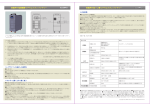





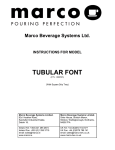

![Handbuch (deutsch) [PDF ]](http://vs1.manualzilla.com/store/data/006804687_1-349a3aed475e4eaa9b965dce892f30c9-150x150.png)
